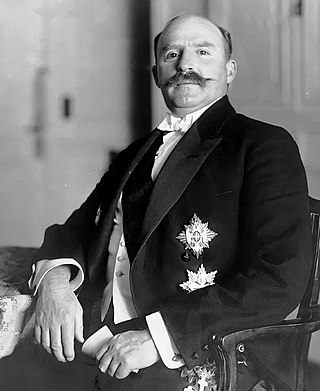
Essad Toptani was an Albanian politician who served as prime minister of Albania from 1914 to 1916. He previously established the Republic of Central Albania based in Durrës. An Ottoman army officer, he served as the Albanian deputy in the Ottoman Parliament and later cooperated with the Balkan League after the Balkan Wars.

Isa Boletini was an Albanian revolutionary commander and politician and rilindas from Kosovo.
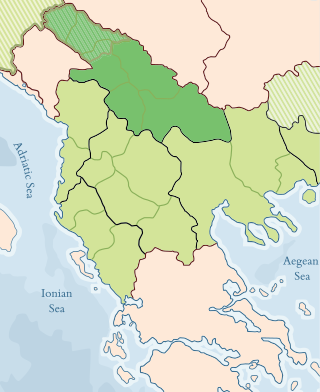
The Vilayet of Kosovo was a first-level administrative division (vilayet) of the Ottoman Empire in the Balkan Peninsula which included the modern-day territory of Kosovo and the north-western part of the Republic of North Macedonia. The areas today comprising Sandžak (Raška) region of Serbia and Montenegro, although de jure under Ottoman control, were de facto under Austro-Hungarian occupation from 1878 until 1909, as provided under Article 25 of the Treaty of Berlin. Üsküb (Skopje) functioned as the capital of the province and the midway point between Istanbul and its European provinces. Üsküb's population of 32,000 made it the largest city in the province, followed by Prizren, also numbering at 30,000.

Hasan bey Prishtina,, was an Ottoman, later Albanian, politician who served as the 8th prime minister of Albania in December 1921.

Gollak or Gallap is a mountainous and ethnographic region in the eastern part of Kosovo and partially in Serbia, bordering the Llap region to the North, the Kosovo field to the west, the Anamorava valley to the south and straddling along the border with Serbia. The cities of Prishtina and Gjilan in Kosovo are located by the mountains. The highest peak, Gollak-Lisica, has an elevation of 1,186 m (3,891 ft) above sea level. Gollak itself is split into Upper Gollak and Lower Gollak.
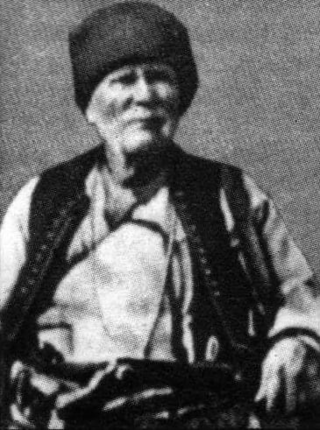
Idriz Seferi was an Albanian nationalist, revolutionary leader and guerrilla fighter who played a prominent role in the Albanian uprisings against the Ottoman Empire, the Kingdom of Serbia and Kingdom of Bulgaria during the late 19th and early 20th centuries. During his 56-year military career, he fought in 35 battles.
Riza Kryeziu (1847-1917), known as Riza Bey Gjakova, was an Albanian nationalist figure and guerrilla fighter, an influential bey in the Gjakova region, then part of the Vilayet of Kosovo, Ottoman Empire, and one of the activists of Albanian national movements of early 20th century.

The Albanian Vilayet was a projected vilayet of the Ottoman Empire in the western Balkan Peninsula, which was to include the four Ottoman vilayets with substantial ethnic Albanian populations: Kosovo Vilayet, Scutari Vilayet, Manastir Vilayet, and Janina Vilayet. In some proposals, it included the Salonica Vilayet as well. The creation of the Vilayet was confirmed in September 1912, but negotiations were interrupted a month later in October by the beginning of the First Balkan War. Plans for an Albanian Vilayet were lost with the Partition of Albania.

The All-Albanian Congress, Albanian National Congress, or Albanian Independence Congress was a held in Vlorë on November 28, 1912. Congress participants constituted the Assembly of Vlorë which established Albanian Provisional Government and elected Ismail Qemali as its president.

The Committee for the National Defence of Kosovo was an Albanian organization founded in Shkodër on 1 May 1918. It mainly consisted of the political exiles from Kosovo and was led by Hoxha Kadri from Pristina. It had existed in looser form since May 1915.
The Sanjak of Niš was one of the sanjaks of the Ottoman Empire and its county town was Niš. It was composed of the kazas of Niš (Niş), Pirot (Şehirköy), Leskovac (Leskofça), Vranje (İvranye), Kuršumlija (Kurşunlu), Prokuplje (Ürküp) and Tran (Turan).

The Malissori uprising or the Albanian revolt of 1911 was one of many Albanian revolts in the Ottoman Empire and lasted from 24 March 1911 until 4 August 1911 in the region of Malesia.
The Kryeziu family was notably powerful and influential in Gjakova and other parts of Dukagjin during the 19th and 20th century. They were part of the Ottoman cast.
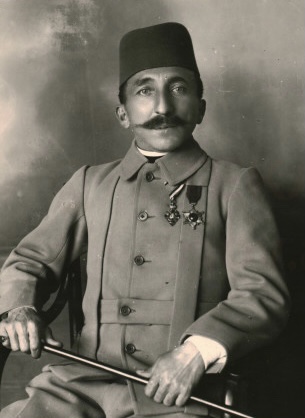
Hysni Curri (?–1925) was a Kosovar Albanian military figure and a prominent leader of the Kachak movement and the Committee for the National Defence of Kosovo.
The Second Congress of Manastir was an Albanian congress held on 2–3 April 1910 in Manastir, back then Ottoman Empire, today's Bitola in the Republic of North Macedonia. It dealt with the challenges that the Albanian language and schools faced at the time within the context of the empire, and the platform to overcome them.
Zef Kol Ndoka (1883-1924), also known among Albanians as Zefi I Vogël, was an Albanian warrior and commander from the Shengji family from today's Fan Mirdita in Northern Albania.
The Battle of Lumë, also referred by the Albanians as the Uprising of Lumë, was a series of clashes between the Albanian locals of the region of Lumë in Ottoman Albania against the invading Serbian army in 1912 during the First Balkan War period. As the Kingdom of Serbia sought to gain access to the Adriatic Sea, the Serbian army met significant resistance from Albanian militia in the Luma region, resulting in the defeat of the Serbian forces. In securing the central Adriatic coast in Albania, Albanian political figureheads were able to disembark in Durrës and proceed with their plans for the eventual Albanian Declaration of Independence.
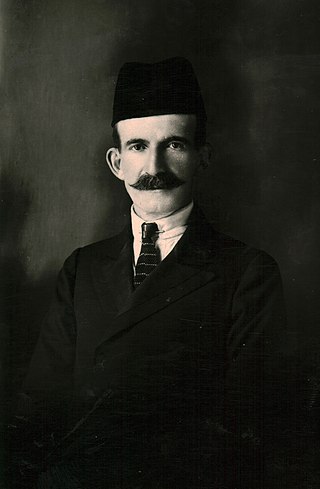
Halim Jakova-Gostivari (1878–1927) was an Albanian politician, lawyer and public official who served as the first director of the Albanian State Police, a post which he held for three separate terms.
At the conclusion of the Albanian-Ottoman Wars in the 15th century, the Albanian people revolted against the Ottoman Empire. These actions during this time continued an extended period of conquest and border expansion into Southeastern Europe. The Ottomans were left in control of all the main Albanian cities, besides Durrës and Ulcinj, which were still controlled by the Venice. Albania would be ruled by the Ottomans for over 400 years, but this rule would be frequently disrupted by revolts and uprisings with varying degrees of success.
The Taksim meeting alternatively known as the Taksim Plot and less commonly as the Taksim Assembly was a secret meeting held in January 1912 by Albanian nationalist deputies of the Ottoman parliament and other prominent Albanian political figures. The event gets its name from Taksim Square because of the location of the house where it was held. The meeting was organized on the initiative of Hasan Prishtina and Ismail Qemali, Albanian politicians, who invited most of the MPs of Albanian origin and aimed at launching an armed general uprising in Albanian territories against the central government headed by the Committee of Union and Progress (CUP). The meeting followed two other Albanian uprisings of 1910 in the Vilayet of Kosovo and 1911 in the mountains of upper Shkodra. The Taksim meeting resulted in an uprising the same year, with armed uprisings in Shkodër, Lezhë, Mirditë, Krujë and other Albanian provinces, which exceeded the organizers' expectations. The biggest uprising was in Kosovo, where the rebels were more organized and managed to take over important cities like Prizren, Peja, Gjakova, Mitrovica and others.














